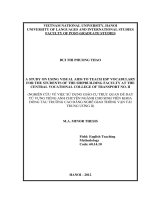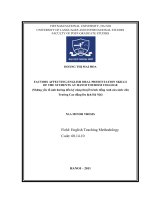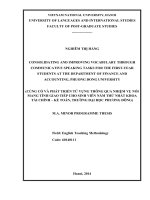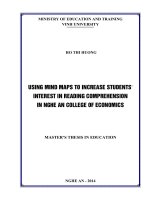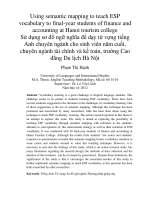Using semantic mapping to teach ESP vocabulary to final-year students of finance and accounting at Hanoi tourism college
Bạn đang xem bản rút gọn của tài liệu. Xem và tải ngay bản đầy đủ của tài liệu tại đây (144.71 KB, 8 trang )
Using semantic mapping to teach ESP
vocabulary to final-year students of finance and
accounting at Hanoi tourism college
Sử dụng sơ đồ ngữ nghĩa để dạy từ vựng tiếng
Anh chuyên ngành cho sinh viên năm cuối,
chuyên ngành tài chính và kế toán, trường Cao
đẳng Du lịch Hà Nội
Phạm Thị Hạnh
University of Languages and International Studies
M.A. Thesis. English Teaching Methodology; Mã số: 60 14 10
Supervisor : Dr. Lê Văn Canh
Năm bảo vệ: 2012
Abstract. Vocabulary learning is a great challenge to English language students. This
challenge seems to be greater to students learning ESP vocabulary. There have been
several solutions suggested in the literature to the challenges of vocabulary learning. One
of those suggestions is the use of semantic mapping. Although this technique has been
promoted and researched by many researchers, little has been done about using this
technique to teach ESP vocabulary learning. The action research reported in this thesis is
an attempt to explore this issue. The study is aimed at exploring the possibility of
teaching ESP vocabulary through semantic mapping with reference to the students’
attitudes to, and opinions of, this instructional strategy as well as their retention of ESP
vocabulary. It was conducted with 38 final-year students of finance and accounting at
Hanoi Tourism College. Although the results from students’ test scores and students’
responses to questionnaire revealed that semantic mapping fosters vocabulary retention to
some extent and students seemed to value this teaching technique. However, it is
necessary to note that the findings of this study, which is an action research study, has
many limitations regarding the research design, the methods of data collection and the
duration of the treatment, can by no means by generalized. Despite those limitations, the
significance of the study is that it encourages the researcher-teacher of this study to
further implement semantic mapping to teach ESP vocabulary as this question has been
little researched by other researchers.
Keywords. Tiếng Anh; Từ vựng; Sơ đồ ngữ nghĩa; Phương pháp giảng dạy
Content.
TABLE OF CONTENTS Page
Declaration i
Acknowledgements ii
Abstract iii
Table of contents iv
List of abbreviations vii
List of tables vii
PART A: INTRODUCTION
1. Rationale of the study 1
2. Aims and objectives of the study 2
3. Scope of the study 2
4. Research questions 3
5. Significance of the study 3
6. The method of the study 4
7. Design of the study 4
PART B: DEVELOPMENT
CHAPTER 1: LITERATURE REVIEW
1.1 What is vocabulary? 6
1.2. The role of vocabulary in second language learning 6
1.3. What is involved in teaching L2 vocabulary 8
1.4. Challenges of L2 vocabulary learning 8
1.5. The nature of ESP vocabulary 9
1.6. Challenges of ESP vocabulary learning 11
1.7. What should be taught in ESP vocabulary teaching 12
1.7.1. Word form 12
1.7.2. Word formation 12
1.7.3. Word relations 13
1.7.4. Collocation 14
1.8. Characteristics of financial & accounting English vocabulary 14
1.8.1. The morphological characteristics 14
1.8.2. The semantic characteristics 15
1.9. Vocabulary retention 16
1.10. Semantic mapping as a vocabulary instruction strategy 16
1.10.1. Definitions of semantic mapping 16
1.10.2. Procedures to construct a semantic map 17
1.10.3. Previous studies of the impact of semantic mapping on students’ vocabulary
learning 19
Benefits of semantic mapping 19
Limitations of semantic mapping 23
CHAPTER 2: THE STUDY
2.1. The context of the study 25
2.1.1. Research setting 25
2.1.2. Teaching materials 26
2.2. Research participants 26
2.3. Data collection instruments 27
2.3.1. Tests 27
2.3.2. Questionnaire 28
2.4. Treatment procedures 29
2.5. Procedures of data collection 31
2.6. Data analysis 31
CHAPTER 3: FINDINGS AND DISCUSSION
3.1. Findings 32
3.1.1. The effectiveness of semantic mapping on students’ word retention 32
3.1.2. Students perceptions of the benefits of semantic mapping to their word retention.
34
3.2. Discussion. 36
PART C: CONCLUSION
1. Summary of the study 38
2. Limitation of the study and suggestions for further study 40
REFERENCES
APPENDICES
References.
1. Antonacci, P. A. (1991). Students search for meaning in the text through
semantic mapping, Social Education, International Reading Association. 55,
pp. 174-5
2. Al-Kufaishi, Adil. (1988), A Vocabulary Building Program is a Necessity not
a Luxury. English teaching Forum, 26(2): 42-44.
3. Abdollahzadeh and Amiri (2009), “The effect of semantic mapping as a
vocabulary instruction technique EFL learners with different perceptual
learning styles”, The journal of Applied Linguistics ,Vol.2, Issue 1.
4. Brikena Xhaferi (2010), Teaching and learning ESP vocabulary, BIBLID,
pp.229-255
5. Barcroft, J.(2004), Second language vocabulary acquisition: A lexical input
processing approach, Foreign Language Annals, 37,2,200-208.
6. Erten, I.H., & Tekin, M. (2008). “Effects on vocabulary acquisition of
presenting new words in semantic sets versus semantically unrelated sets”.
ELSIVIER, 36, 407-42
7. Fraser, S. (2005), The Lexical Characteristics of Specialized Texts. Retrieved
April 22, 2010 from jalt-publications.org/archive/proceedings/2004/E115.pdf
8. Firth, J. R. (1957). A synopsis of linguistic theory [ Reprinted in: Palmer, F.
R. (ed.) (1968). Selected Papers of J. R. Firth 1952-59, pages 168-205.
Longmans, London. ]
9. Ghazal, L.(2007). Learning vocabulary in EFL contexts through vocabulary
learning strategies. Novitas-Royal 1 (2), 84-91.
10. Gairns, R. and Redman, S. (1986), Working with Words: A guide to teaching
and learning vocabulary, Cambridge University Press, Cambridge.
11. Gunning, Thomas G.(1992). Creating Reading Instruction for all Children,
Allyn and Bacon, London.
12. Harmer, J. (1991), The Practice of English Language Teaching, Longman,
London
13. Hornby, A.S. (1995), Oxford Advanced Learners Dictionary of Current
English, Oxford University Press, London.
14. Jensen (1998), E. Teaching with the Brain in Mind, ASCD Publication,
Alexandria Virginia
15. Johnson, D., Pittelman, S. & Heimlich, J. (1986). “Semantic mapping”, The
Reading Teacher, 39(8), 778-782, International Reading Association
16. Kenedy, C. & Bolitho, R. (1984), English for Specific Purposes, Macmillan
Press Ltd, London
17. Laufer, B. (1998). “The development of passive and active vocabulary in a
second language: same or different?” Applied Linguistics 12, pp.255-271
18. McCarthy, M. (1990), Vocabulary. O.U.P
19. Morgan, J. and Rinvolucri, M. (2004), Vocabulary (second edition), Oxford
University Press, Oxford.
20. Mergel, B. (1998). Instructional Design and Learning Theory. Retrieved
October 31, 2005, from
21. Nation, I.S.P., (2001). Learning vocabulary in another language, Cambridge
University Press, Cambridge.
22. Nation, I.S.P. (1990), Teaching and Learning Vocabulary, Newbury House,
New York.
23. Norbert Schmitt and Michael McCarthy ( 1977), Vocabulary: Description,
Acquisition and Pedegory, Cambridge university press, Cambridge.
24. Nunan, D. (1992), Research methods in language learning, Cambridge
University Press, Cambridge.
25. Nguyễn Phước Vĩnh Cố & Bùi Thị Kim Yến (2011), Lexical and semantic
features of a financial, accounting, and banking English text, Tạp chí khoa
học và công nghệ, Đại học Đà Nẵng, 4, pp.245-254
26. Oxford, R. (1990), Language learning strategies: What every teacher should
know, Newbury House , New York.
27. Oxford Advanced Learner's Dictionary (1992), Oxford University Press
28. Pyles, T. and Algeo, J. (1970), English – An Introduction to Language,
Harcourt, Brace and World, New York.
29. Robinson, P.C. (1991), ESP today: A Practitioner’s Guide, Prentice Hall,
New York .
30. Scott Thornbury (1997), How to Teach Vocabulary, Pearson ESL
31. Sprenger (1999), M. Learning and Memory - The Brain in Action, ASCD
Publication, Alexandria Virginia.
32. Sinatra. R. C., J. Stahl-Gemakel, and D. N. Berg. (1984), “Improving reading
comprehension of disabled readers through semantic mapping”. The Reading
Teacher, 33, pp. 22-29, International Reading Association.
33. Stoller, F.L. (1994), Making the most of a newsmagazine passage for reading
skills development. Forum, 32 (1), Retrieved January 23, 2007, from
hanges
34. Svenconis and Kerst (1995), “Investigating the teaching of second-language
vocabulary through semantic mapping in a hypertext environment”. CALICO
journal, volume 12 numbers 2&3
35. Susan and Mehrdad ( 2011), “Enhancing vocabulary retention through
semantic mapping : a single-subject study”, The international Journal
Language Society and Culture 32, pp.11-15
36. Saeidi and Atmani (2010). “Teaching vocabulary through semantic mapping
as a pre-reading Activity across Gender”. Archive of SID 1(1), 51-64.
37. Stoller, F & Grabe, W. (1993). “Implications for L2 vocabulary acquisition
and instruction from L1 vocabulary research”. In T, Huckin, M, Haynes & J,
Coady (Ed.), Second language reading and vocabulary learning (pp. 24-39),
Ablex Publishing Corporation, New Jersey .
38. Trimble, L. (1985), English for Science and Technology: A Discourse
Approach. Cambridge University Press, Cambridge.
39. Tinkham, T. (1993), “The effects of semantic and thematic clustering on the
learning of second language vocabulary”, SAGE journals, Second Language
Research, 13(2), 138-163.
40. Ur, P. (1996), A course in language teaching, Cambridge University Press,
Cambridge.
41. Waring, R. (1997), “The negative effects of learning words in semantic sets”
, ELSIVIER, 25(2), 261-274.
42. Wilkins, D.A. (1972), Linguistics in Language Teaching London, Oxford
University Press, Oxford.

